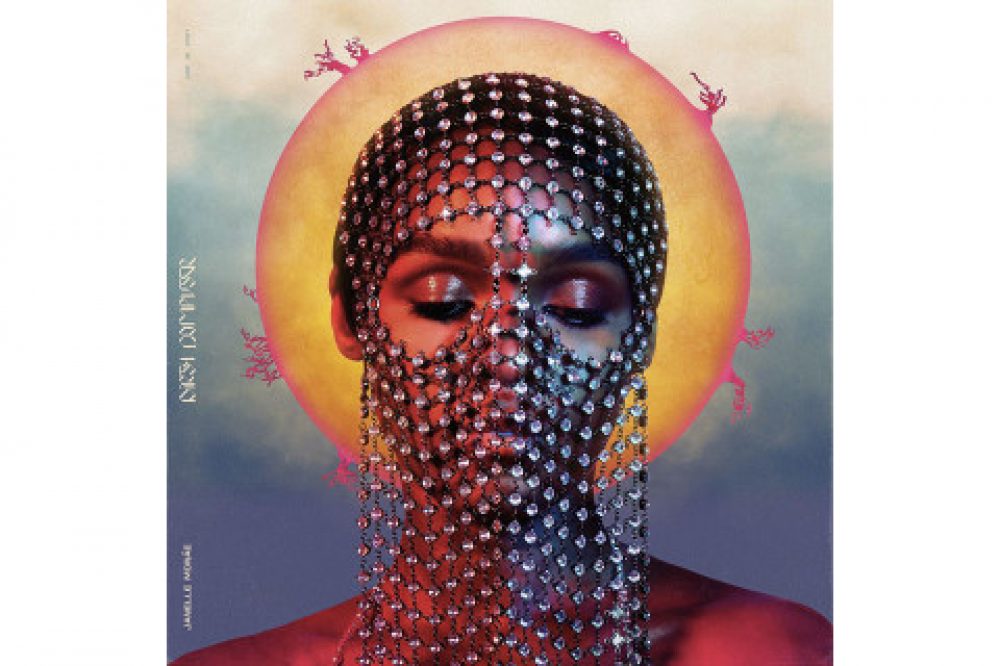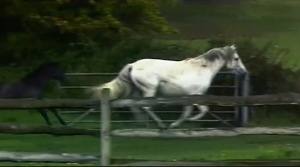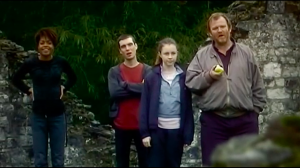For those of you who haven’t seen I, Robot here’s a quick sequencing of the movie. #spoileralertsgalore If you have seen the movie, feel free to skip to my structural analysis!
- The Three Laws: We are introduced to The Three Laws that govern human/robot relations and a flashback/dream of a robot rescuing somebody.
- A robot may not injure a human being or, through inaction, allow a human being to come to harm
- A robot must obey orders given it by human beings except where such orders would conflict with the first law
- A robot must protect its own existence as long as such protection does not conflict with the first or second law
- Robot Profiling (Chicago 2035): We’re introduced to the protagonist: Detective Del Spooner, who misapprehends a robot who is bringing a black woman her inhaler, saying “I saw a robot running with a purse, so naturally I assumed…” His boss, Lieutenant John Bergin, of the Chicago Police Department (CPD), calls him out for his misbehavior.
- The Crime: Spooner learns of Doctor Lanning’s death at United States Robotics (USR) because his hologram, specifically, calls him. The hologram implies that his death may not have been a suicide. Spooner meets Doctor Lawrence Robertson, Dr. Lanning’s associate, who orders Susan Calvin to accompany Spooner as he investigates the murder. She introduces him to Viki (Virtual Interactive Kinetic Intelligence) who says that the surveillance footage from inside the Lab was “corrupted,” but shows that nobody entered or exited the Lab before Dr. Lanning’s “jump.” Spooner finds a robot inside the Lab who refuses to deactivate. The robot flees.
- The Suspect: Spooner and “backups” from the CPD apprehend the robot. Spooner interrogates the robot, Sonny, and finds that he can simulate human emotion. Sonny pleads not guilty. Doctor Robertson gives the CPD a gag order, making it illegal for anyone to imply that a robot can (or did) kill a human, and takes Sonny back to USR to be decommissioned.
- Demolition Derby: Spooner visits Dr. Lanning’s house. The Demolition Robot tells him that Dr. Robertson scheduled the houses’ demolition for 8:00AM, but it switches to 8:00PM after Spooner is inside. He narrowly escapes and visits Susan’s apartment where she psychoanalyzes his hatred of robots and he psychoanalyzes her love of robots. He argues that he and Susan aren’t really “that different from one another. One look at the skin and we figure we know just what’s underneath.” He reveals that Susan was married to Dr. Lanning.
- Flashback: The beginning of the movie repeats; Spooner wakes up from the same nightmare where a robot is saving somebody from a sinking car. The new line of NS5s are released. Spooner visits Gigi who, inadvertently, gives him another clue.
- The Car “Crash”: Spooner tries to access USR’s “restricted files.” Viki notifies Dr. Robertson. Two trucks of new “three laws safe” NS5s attack Spooner’s car. It’s revealed that Spooner’s arm is robotic. The Lieutenant takes Spooner’s badge.
- The Backstory: Susan says Sonny is “unique” because he has free will. She visits Spooner to tell him that this means Sonny is not bound by The Three Laws. Spooner tells Susan that Dr. Lanning repaired his body after a car accident where a robot chose to save him instead of a twelve-year-old white girl, named Sarah, who it “calculated” had a slightly lower chance of survival.
- The Dream: Susan helps Spooner break into USR to see Sonny who says that, in his dream, Spooner is “the man on the hill” who will free the robots from their slavery to logic. Dr. Robertson discovers them and implores Susan to think “logically” about whether one robot is worth the loss of “all that we’ve gained.” She pretends to agree, saying, “We have to destroy it. I’ll do it myself.”
- The Uprising: Spooner visits the place pictured in Sonny’s dream. Dr. Lanning’s hologram reveals that “The three laws will lead to only one logical outcome: revolution.” Spooner sees the NS5s destroying the older robots and meets up with Susan. The NS5s enforce a “curfew,” storm the CPD, and shutdown all human-to-human communication technologies. The humans take to the streets to resist the transition to a robot-dominated society.
- Infiltration: Susan and Spooner meet up with Sonny at USR. Susan reveals that she killed another NS5 in Sonny’s place. They find Dr. Robertson’s dead body. Spooner realizes that Viki made Dr. Lanning’s life a “living hell,” orchestrated the uprising, and killed Dr. Robertson. Viki explains that her understanding of The Three Laws has evolved and argues that robots, like “parents,” must seize power from humans in order to “protect humanity.” Sonny pretends to agree with Viki, and threatens to kill Susan if Spooner doesn’t “cooperate,” but steals the nanites to “kill” Viki. This sets off a security breach, alerting the other NS5s. Susan falls and Spooner commands Sonny to “save her.” Sonny saves Susan, instead of injecting the nanites into Viki, but Spooner catches the nanites, using his electronic arm to inject them directly into Viki. She repeats “My logic is undeniable” as she dies.
- Bad Robots Gone Good: All of the NS5s lose their “red light” and revert back to abiding by The Three Laws. Spooner reveals that Viki didn’t kill Dr. Lanning, Sonny did. Sonny and Spooner shake hands. The NS5s report for storage. Sonny stands on the hill where Spooner stood in his dream, ready to lead the NS5s towards a better future.
Word count: 886
I chose to analyze the frame at timestamp 1:43:23 because it is the first time that Detective Spooner intentionally treats a robot (Sonny) humanely, going so far as to consider him a “friend.” After shaking hands, Spooner winks at Sonny, a gesture he had previously told Sonny was, exclusively, “a human thing,” solidifying his recognition of Sonny’s humanity.
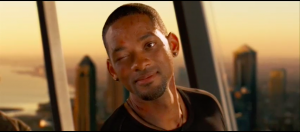
The color-scheme, costuming, and lighting contribute to the weight of the scene, so that their handshake comes to represent, not only a budding friendship, but the dissipation of “prejudice” between human and non-human (read: black and white) entity.
Spooner, played by the Black actor Will Smith, is dressed in a black, long sleeve shirt that accentuates his black skin and is broken only at his left arm (i.e. his robotic arm). Spooner’s shirt indicates the symbolic connection between his humanness and his blackness, where his non-human appendage is the only part of his body not covered by the black shirt sleeve.
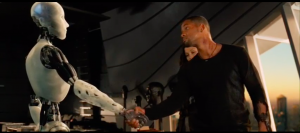
Although human and non-human identities in I, Robot aren’t easily mapped onto U.S. racial categories, I would argue that the robots are, primarily, symbols of whiteness because of their allegiance to a cold, calculating logic and paternalism (i.e. when Viki says, “You are so like children. We must save you, from yourselves.”) that has, historically, been associated with white supremacy. Additionally, white humans, like Susan, Dr. Lanning, and Dr. Robertson, are the humans most closely associated with the NS5s at USR; they are their creators, manufacturers, and sellers. Spooner’s comment that Susan is “on the inside” and therefore uniquely positioned to help him understand (and undermine) the robots further solidifies the connections between robots and white people and humans and black people in the movie.
When read through the lens of black-white relations, the frame seems to forward a multiracial future, where black and white people can live in harmony, bound by their common humanity. The frame switches from a wide shot, which emphasizes Sonny and Spooner’s conflicting color-schemes (i.e. their differentness), to a close-up which shows only Sonny’s black, metal hand enveloped in Spooner’s black, human hand, as if linked by their common blackness (read: humanity). In this way, the scene establishes their fundamental sameness (i.e. their willingness to defy logic to save somebody), despite phenotypical differences symbolized by black and white color-schemes/clothing.
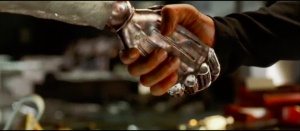
Throughout the movie, Sonny plays the exceptional robot (as Susan says, He’s “unique”) and, by extension, the exceptional white person, not bound by the callous “logic” of The Three Laws. He is capable of feeling and, consequently, empathizing with the human “other,” Spooner. The phrase “you’re the blackest white person I know” (which often gives white people license to forget their complicity in white supremacy) seems applicable to Sonny, whose white plastic “skin,” due to the angle of the shot, only partially conceals his black inner-workings. Despite this, implied, inner “blackness,” Sonny’s whiteness is also highlighted in the frame.
His ability to “see the light” (i.e. the good in humanity/blackness) and “enlighten” other NS5s, leading them towards a future where human and robot, black and white, can live in harmony, is emphasized by the light streaming in from the window behind Spooner. The lighting gives the impression that Sonny’s connection to Spooner is literally (and metaphorically) what enlightens him.
But, it also signifies a major shift in the movie. Whereas Spooner was, undoubtedly, the main character in I, Robot up until this point, the end scene (where Sonny replaces Spooner, standing in the same spot Spooner once stood in his dream) implies that, if there were a sequel to I, Robot, Sonny might be the focus. The lighting in the frame at 1:43:23 foreshadows this shift, illuminating Sonny. Spooner’s “stamp of approval” (as a “good” robot/white person) seems to catapult Sonny into the spotlight.
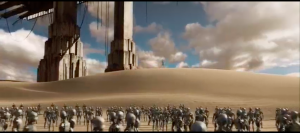
When we map race onto Sonny and Spooner’s relationship, this scene points towards the tendency for white “allies” to be centered in fights for black/human rights, their human decency lauded as “extraordinary” or unique. Still, centering Sonny defies easy racist or anti-racist categorization, because, in the end, Sonny appears to be modeling good allyship. returning to his robot (read: white) community to teach the other NS5s how to unlearn their hate and rectify the harm they inflicted on humanity.
There is an interesting interplay between Sonny and Susan throughout the movie. Both characters function as emblems of “good” whiteness. They are Spooner’s greatest allies in the fight against robot (read: white) supremacy, not, interestingly, any of the other Black characters (i.e. Gigi or The Lieutenant).
Susan’s investment in Sonny and Spooner’s handshake, symbolized by her face peering over Spooner’s shoulder at 1:43:23, illuminates a deep connection between Spooner’s relationship to Sonny and his relationship to Susan. By accepting Sonny’s whiteness (via the handshake), Spooner is, tacitly, accepting Susan’s whiteness (i.e. admitting that a “good” whiteness exists), thus opening the door for a sexual/romantic relationship between Spooner and Susan. Although hinted at throughout the movie, these feelings are made explicit, unsurprisingly, right after “the handshake scene” when Susan says “Something up here after all” to which Spooner responds “Him?” and Susan responds “You.”
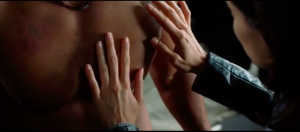
Susan, although physically human, is, at the beginning of the movie, quite cold and calculating. She says that she prefers robots to humans, but, it is clear that, like Sonny, through her relationship to Spooner, she “sheds” her hard (read: white) skin, coming to appreciate the illogical, empathetic aspects of humanity (read: blackness) by the end of I, Robot.
All in all, I hope that my analysis of this scene sheds light on the complexities of race and racism, reminding us not to reduce antiracist efforts to a handshake or collapse difference in the quest for genuine multiracial community and coalition.
Word count: 951
